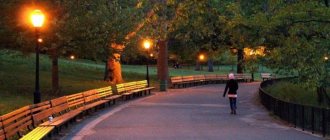Again the lights don’t work and you have to get home using your smartphone to illuminate the road. Where to complain about street lighting, which doors to knock on? The dispatcher of the power grid organization sends it to the management company, which, in turn, redirects it to the administration. Officials insist that the Criminal Code is to blame for everything, so you need to complain about it to the Housing Inspectorate. Vicious circle. Time passes, but the lights are still not on.
Standards and requirements
To have an idea of how to defend your rights in the event of a lack of lighting, you need to understand how street lighting is arranged. The main points of SNiP rules and building codes are:
- monuments and architectural objects must be illuminated,
- lighting of main and secondary roads is carried out taking into account the type of road surface and its ability to reflect light,
- For each individual object, a specific level of horizontal illumination is provided, so for highways this value corresponds to 20 lux, for regional roads - 15 lux, for streets 4-6 lux is enough.
Watch the video: How city lighting works
Street lighting standards
To ensure the proper level of illumination, there are SNiP standards that define standards for streets, roads and other external areas, and instructions for designing external lighting in populated areas.
Conventionally, settlement territories are divided into 3 types:
- local roads and streets;
- streets and roads of regional significance;
- express roads.
Average illumination levels depend on traffic intensity:
- adjacent areas should have an illumination of 4 lux;
- squares, roads, streets with traffic up to 500 people per hour - the illumination standard is 6 lux;
- from 500 – 8 lux;
- from 550 to 1000 - at least 10 lux;
- District streets and highways with a traffic volume of 1000 people or more require 15 lux;
- when 3,000 people or more pass through, a luminous flux of 20 lux must be provided;
- According to standards, bridges, interchanges, road overpasses and city squares require an illumination level of 20 or 25 lux.
Types of pillars and the order of their installation
In order for the level of light to be sufficient for the designated area, it is necessary to install the lamps at a certain height. Special supports made from different materials are designed for this:
- Tree. Mainly coniferous species are suitable for this. The cost of such poles is low, they are light in weight and easy to install. They are also quite safe in emergency situations. However, they are not durable and require treatment against rotting.
- Concrete. Their price is also low, easy to use and have a long service life. However, groundwater flow is undesirable near such supports.
- Reinforced concrete. This type of support is durable, not subject to corrosion, and inexpensive. But it requires high installation and maintenance costs.
- Metal (aluminum or steel) . Although the price of such poles is quite high, they are strong and durable.
When installing supports, it is important to pay attention to the foundation. The depth for lawn installation cannot be less than 80 cm. For other types of installation, the depth should not be less than 160 cm.
Other requirements include:
- the gap between the supports must be at least 60 cm,
- installation of supports in one row,
- the supports are arranged in two rows in a checkerboard or rectangular pattern.
The distance from the road curb is affected by traffic intensity:
- if there are no trucks on the roads - 0.3 m,
- secondary roads – 0.6 m,
- highways – 1 m.
Types of lamps
Different lamps can be used for street lighting:
- sodium,
- mercury,
- LED,
- metal halide lamps.
You can increasingly see LED lights. The main differences between LED devices are:
- efficiency,
- strength,
- durability,
- resistance to moisture, temperature changes,
- uniform bright light.
Street lighting is necessary in order to ensure safe traffic movement, the convenience of pedestrians, and a sense of security in the dark.
More about functional usage
Lanterns on the roads solve several problems at once: they provide relative safety in the dark, illuminate the area and give the area some attractiveness, adding a feeling of comfort. Street lighting is divided into types according to different parameters.
There are lamps that differ in their intended purpose:
- Lanterns;
- Architectural lighting;
- Decorative lighting.
Lamps can also be used in different types: sodium, mercury, metal halide and LED. Sodium lamps are most often used on poles illuminating roads, sidewalks, squares and parks, but LED lamps are gradually being introduced. Lanterns are also presented in a variety of options, differing in the type of material of the supporting structure, the shape of the bracket and the shade.
The lighting can be controlled automatically or manually, it all depends on the type of lamp. But gradually there is a transition to automation. However, servicing lamps requires the regular participation of qualified workers, so it is not yet possible to completely switch to automated control of the lighting system.
Who is responsible
According to the law of 06.10.2003 No. 131-FZ “On the general principles of organizing local self-government in the Russian Federation”, the territories of residential buildings, microdistricts, blocks, industrial organizations and communal services, alleys, roads, streets, bridges, boulevards, and therefore courtyards, are located under the control of local authorities.
Read also: Structure of local governments.
ATTENTION! Article 16 states that the city administration establishes a lighting schedule at night at the listed facilities. However, building owners must maintain lighting.
Energy-saving organizations, which are commercial structures, are engaged in lighting urban areas. They draw up an agreement with a local organization or other persons and provide them with their services. The construction and repair of power lines is entrusted to the same specialized organizations with which the administration enters into an agreement.
Read also: Power transmission line security zone: what you need to know before buying a plot
However, this all applies to public areas (gardens, parks, squares, boulevards). Yards are not included in this list.
They belong to the local area. This is completely different. This area is intended for recreation, playgrounds, sports, plantings, sidewalks, and parking. The Housing Code of the Russian Federation (Part 2, Article 162) states that an agreement is drawn up between the owners of apartments, the partnership, the management body of the housing cooperative, and sometimes with the developer and the management company (Part 14, Article 161 of the Housing Code of the Russian Federation).
The agreement contains information about services and work related to the maintenance of common property and its repair, as well as the provision of utilities. Such services are paid. The Housing Code of the Russian Federation (Parts 1 and 2 of Article 154) states that their fee is included in the receipts for payment for the services provided.
Read also: Mosoblgaz - how to find out the debt on a personal account?
Contact the administration
If there is no response, then you need to contact the city administration directly, since it has an agreement with the electrical networks serving each district. They will take action by contacting the power company, who will have to evaluate the condition of the lighting fixture and make specific repairs. An appeal in the form of a collective or private complaint with signatures is carried out in the form of a regular application in any form and is submitted to the local Administration of a certain municipal body.
In the text of the appeal, it is important to indicate the following questions to the local administration:
- Which organization is responsible for maintaining lighting fixtures on site?
- As the name of the customer under the contract with this organization
- Who is responsible for maintaining lighting at the required level?
Regarding the issue of insufficient street lighting, you should contact the Management Company by writing an application individually or collectively using the same template. The main thing is to write the full name of each applicant, signature and address of his residence. It is important to understand that the Management Company is directly responsible for the life and health of citizens and it is we who should point out the shortcomings to it, since we have a direct interest in this.
In a situation where there is a complete lack of light in your yard, you must contact the local administration, guided by the Federal Law of October 6, 2003 No. 131-F3 “On the general principles of organizing local government in the Russian Federation,” obliging local governments to organize street lighting properly. Which is also regulated by GOST regarding the procedure for organizing lighting, where all standards are prescribed. After completing and sending the application, the response should arrive within seven working days to a month.
Also, to understand the essence of the problem, building codes and regulations are presented here.
Lighting of architectural objects and cultural monuments is a mandatory measure when organizing a street lighting system.
Illumination of main and secondary roads is carried out taking into account the type of road surface and its reflective properties.
Each street provides a certain degree of horizontal illumination. For example:
- for wide roads this parameter corresponds to 20 lk,
- regional roads are illuminated within 15 lk,
- for local streets 4-6 lux is enough.
If you receive a refusal, you can file a complaint with the local organization responsible for maintaining street lighting. Very often refusals are justified by insufficient funding, but these explanations do not make things any better.
Your next step may be to contact the court or prosecutor's office at your place of residence. It is advisable to provide a photo of the area where there is no light and a written (or digital) refusal from the Administration responsible for street lighting.
No light on the streets or in the yard
First you need to identify the problem:
- light bulb needs replacing
- poor lighting or additional lighting required,
- there is no lighting.
If there is visible damage to the light bulb, you can first report it to the housing and communal services manager. The telephone number is provided on the website of the corresponding company.
If the problem is not solved, you need to go to the City Administration, since it is the one who enters into an agreement with the electrical networks.
Villages and towns
The budgets of villages and small towns do not always adequately finance street lighting. Installing lights near every road is quite expensive. Every year, a plan is drawn up to supply street lights and local authorities review it according to the budget.
IMPORTANT! There are certain places where the installation of lights is mandatory, such as road intersections, where the likelihood of accidents is high, as well as educational institutions and administration buildings.
The district department of Energosbyt is responsible for maintenance, but control over the implementation of its duties is entrusted to the local municipality. The right decision would be to contact them orally, in writing (by filing a complaint) or simply by calling.
If there is no lighting along the street or in the courtyard of a residential building, you should contact the relevant authorities with this issue. However, you should not hope for a quick solution to the problem, since it cannot be solved with lightning speed.
The answer to the question of where to complain if there is no lighting on the streets will depend on the territory in question.
Where and how to contact
Do city residents who are dissatisfied with the quality of street lighting know where to complain that commercial organizations are not fulfilling their duties in good faith? The solution to the problem depends on the citizens’ knowledge of their rights and laws, since if lamps near the house break down and there are no street lights, they must contact different authorities.
City residents, depending on the identified problem, have several options to correct the situation. They can contact the following organizations:
- City Housing and Public Utilities Service . The organization operates and maintains street lighting networks, including turning street lights on and off.
- City administration or executive committee . The organization is responsible for strict compliance with the standards and requirements established for the organization of high-quality street lighting.







